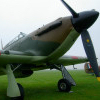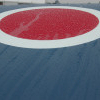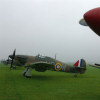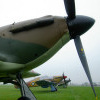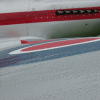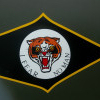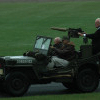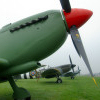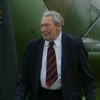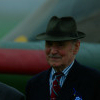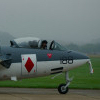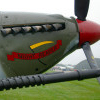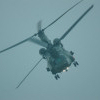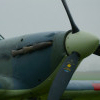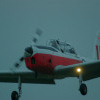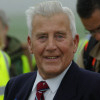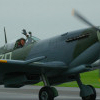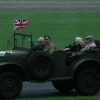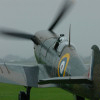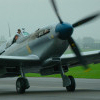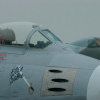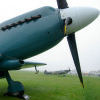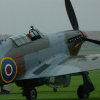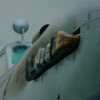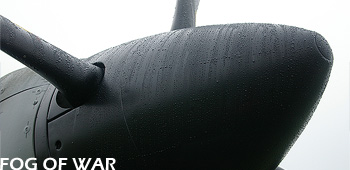
Duxford Air Show 2005 Review
Saturday 10th September - Sunday 11th September
As the participation list grew for the IWM's Battle of Britain airshow on 10 and 11 September, so did the anticipation. Mixed prop and jet formations, and large 'Balbos' of Spitfires and Hurricanes were amongst the expected mouth watering attractions, in a display held as a tribute to the 'Few'. Sadly the British weather decided to play a major part in the weekend's events, especially on the Sunday when your reviewer was in attendance.
braved the conditions to bring this report. All photos by the author.
Sunday morning dawned overcast with a very low cloud base, but the weather forecast gave us hope for a clearer afternoon, with the hope of seeing some action. Sixty-five years ago today, 11 September 1940, was very much the same - although the 'action' was of a very much more serious nature. This was the very day that Hitler had originally planned to invade Britain. Although these plans had since been delayed to that of a later date, this day was still an important one for the Luftwaffe and it's intentions to gain air supremacy over the skies of this country. Somehow the beleaguered RAF was still standing firm in the face of massive onslaughts, and may have been relieved at the morning's 'clag' that kept the German Air Force on the ground.
In a broadcast on this day Winston Churchill announced: 'The effort of the Germans to secure daylight mastery of the air over England is of course the crux of the whole war. So far it has failed conspicuously...'. Then the weather cleared. The German war machine was going to try again...
At 14:45 hours the radar stations along the coast of Kent detected large formations of enemy aircraft over France. The RAF stations were alerted. The 12 Group Duxford 'Bader' Wing of 19, 242 and 310 squadrons were placed at readiness.
The invaders were sighted crossing the Channel at 15:15 hours. Two large formations of one hundred and fifty bombers each - with hundreds of escorting Bf109 and Bf110 fighters - approached Kent, whilst another force arrived over Portsmouth. By 15:30 the defending Spitfires and Hurricanes of the Southern sectors of 11 Group had joined battle. The attacking force battled on and soon reached the Thames and headed towards London, with the RAF trying their best to stop them. Hundreds of fighters and bombers were caught up in a huge melee over the Thames estuary. The Spitfires of Duxford's 19 Squadron had been scrambled to protect the airfields of Hornchurch and North Weald and were soon embroiled in the action over East London. In a familiar situation for a day during the period - despite the RAF's best attempts - the bombers managed to get through to hit London, but in doing so the Luftwaffe had suffered heavy losses which eventually led to the cancellation of the planned invasion, and to the RAF being able to claim a hard fought victory in the Battle of Britain.
Seventeen gallant young RAF pilots lost their lives that day in the defence of Britain, and it was for them and the rest of the 'Few' that we had gathered at Duxford to show our gratitude. A large gathering of Battle of Britain veterans had been invited to attend to receive the thanks of the public - a gathering that may be their last in such numbers as time catches up with them. We salute you.
So there we were, in 2005, hoping that the weather would follow that of sixty-five years previously. Unfortunately the time of the first item of the air display had arrived, but the cloud base was still down at around 100 feet - way too low for most of the acts to even consider getting airborne. It looked at one point that we would see no flying at all. The Royal Navy Historic Flight's Sea Hawk departed for it's home base at Yeovilton - which was a surprising decision in the circumstances, but at least gave us something to watch, however briefly.
Thankfully the 18 Squadron Chinook pilot, Flight Lieutenant Carl Zarecky, offered to put on a 'limited' display that was gratefully received by the surprisingly large audience (given the weather conditions), and after making a few 'circuits' to check out the visibility was able put on the very spritely display that it and the RAF Merlin have come to make as their own. Flying sideways, making steep 'wingovers' and the kind of hand brake turn maneuver that it does made for some great entertainment.
Alan Walker in a Chipmunk then got aloft for what we were told was to be a 'Met' flight. He checked out the cloud base over the airfield - about 100 to 200 feet - and that over Cambridge - that being the weather that was supposedly coming our way - and that was reported as about 500 feet. Still not good.
In the meantime the real stars of the day - the Battle of Britain veterans - had boarded a number of assorted ex-military vehicles and were taken in a cavalcade in front of a very appreciative audience who clapped and cheered and waved flags and umbrellas. Many of the 'vets' are quoted as saying that they feel embarrassed at the attention, and that they were just normal people in an abnormal situation. Well, I guess we would counter that by saying that they took on that abnormal situation in a very exceptional way. Heroes one and all.
Upon the Chipmunk's return he was cleared to carry out some ad-hoc flying. Alan proceeded to entertain the damp gathering with steep turns, some low go-arounds and a touch and go. Not the most exciting display ever - but a great improvement over watching the grass grow!
The result of the Chippie's recce mission was the announcement that there would be no more fixed-wing flying for the day. No formation of a Spitfire and 56 Squadron Tornado F3. No RAF Hawk, Hawk 75 and RNHF Seahawk grouping. Perhaps most disappointing was not seeing the massed formations of Spitfires, or any of the other Warbirds on what most definately should have been their day. It was decided that some of the Hurricanes and Spitfires would taxi along the crowd line so that at least we would get to hear the sounds of their Merlins - the sound of freedom. This they did with much appreciation from the crowd - a crowd that had remained remarkably restrained despite paying out for Duxford's sometimes critically high entry price. After this the Chinook took to the air again for an encore - this time with the 'loady' crewman waving a glow stick in the murk! Another very slick display given the trying conditions.
So ended a rather disappointing day - but a day in which a much bigger event was being remembered that, perhaps, overcame much of the unfulfilled expectation.

